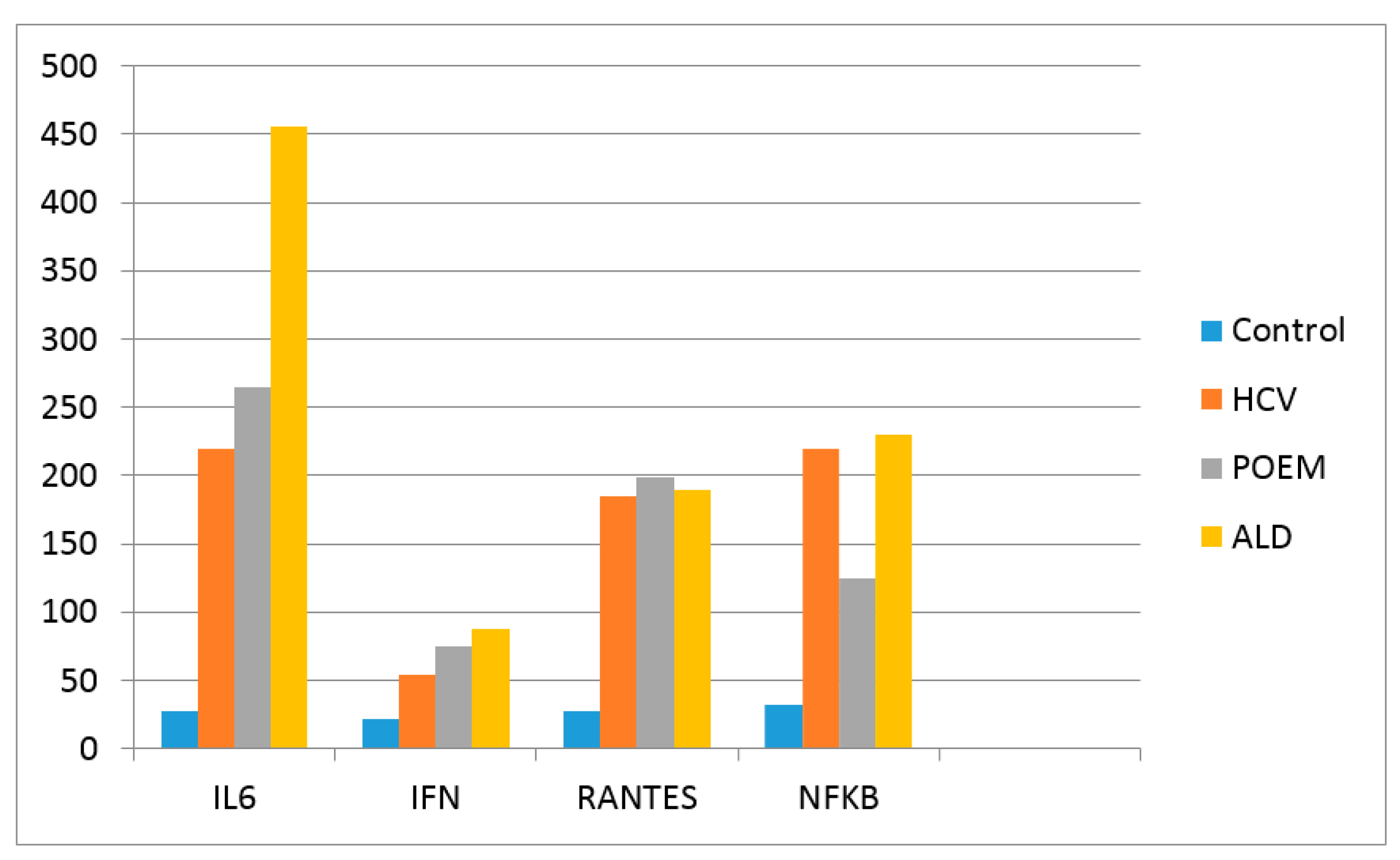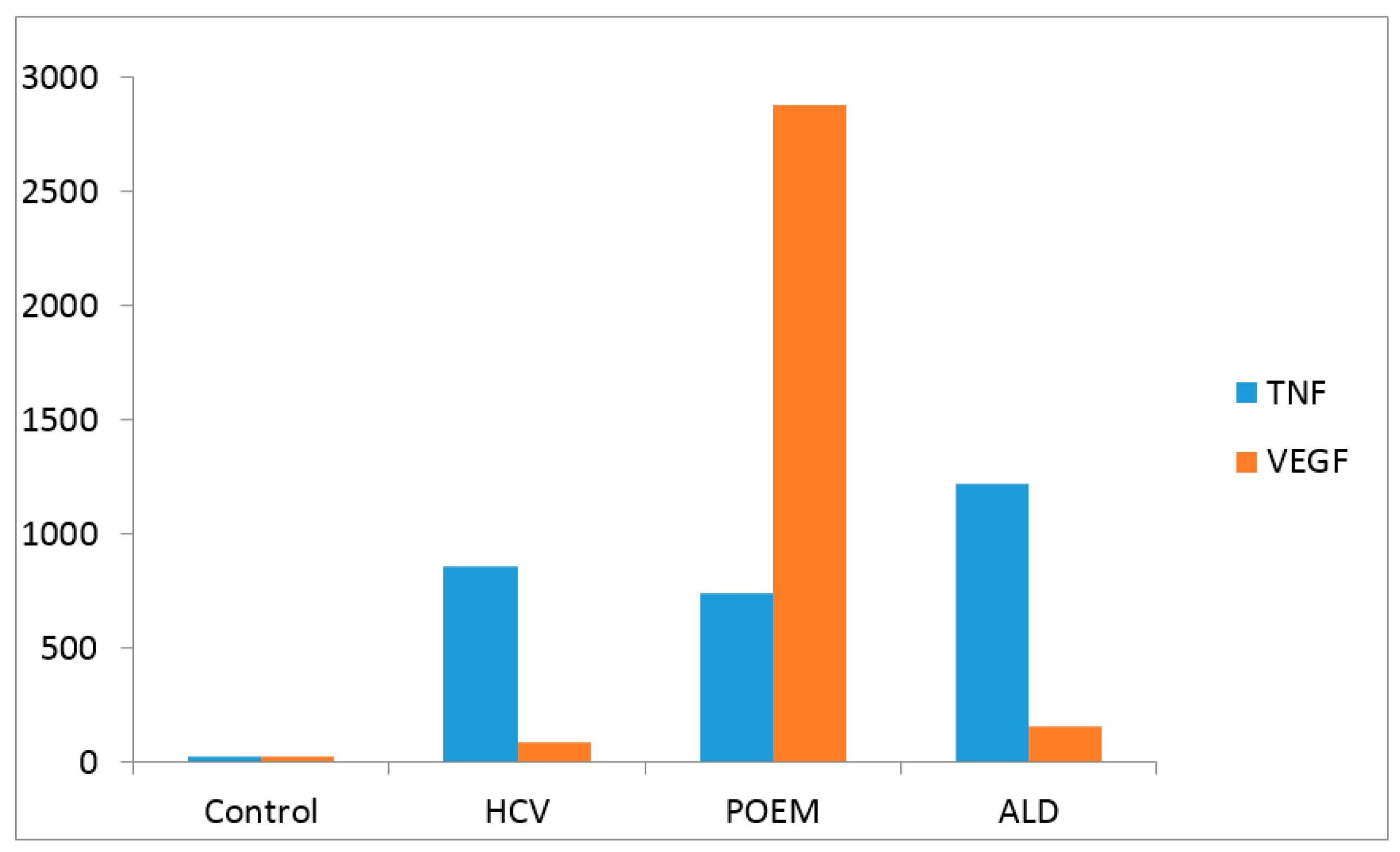Alcohol Misuse Link to POEMS Syndrome in a Patient
Abstract
:1. Introduction
Case Report
2. Laboratory Methods
3. Results
4. Discussion
5. Conclusions
Acknowledgments
Author Contributions
Conflicts of Interest
Abbreviations
| ALD | alcoholic liver disease |
| ALT | alanine amino transferase |
| AST | aspartate aminotransferase |
| HCV | hepatitis C virus infection |
| IL | interleukin |
| IFN-γ | Interferon gamma |
| NFκB | Nuclear Factor kappa-B |
| POEMS | peripheral neuropathy, organomegaly, endocrinopathy, monoclonal plasma cell disorder, skin changes |
| RANTES | Regulated-upon-Activation Normal-T-cell-Expressed and presumably-Secreted |
| TNF | tumor necrosis factor |
| VEGF | vascular endothelial growth factor |
References
- Gosselin, S.; Kyle, R.A.; Dyck, P.J. Neuropathy associated with monoclonal gammopathies of undetermined significance. Ann. Neurol. 1991, 30, 54. [Google Scholar] [CrossRef] [PubMed]
- Joint Task Force of the EFNS and the PNS. European Federation of Neurological Societies/Peripheral Nerve Society Guideline on management of paraproteinemic demyelinating neuropathies. Report of a Joint Task Force of the European Federation of Neurological Societies and the Peripheral Nerve Society-first revision. J. Peripher. Nerv. Syst. 2010, 15, 185. [Google Scholar]
- Ritz, M.F.; Erne, B.; Ferracin, F.; Vital, A.; Vital, C.; Steck, A.J. Anti-MAG IgM-penetration into myelinated fibers correlates with the extent of myelin widening. Muscle Nerve 1999, 22, 1030–1037. [Google Scholar] [CrossRef]
- Kawagashira, Y.; Koike, H.; Tomita, M.; Morozumi, S.; Iijima, M.; Nakamura, T.; Katsuno, M.; Tanaka, F.; Sobue, G. Morphological progression of myelin abnormalities in IgM-monoclonal gammopathy of undetermined significance anti-myelin-associated glycoprotein neuropathy. J. Neuropathol. Exp. Neurol. 2010, 69, 1143–1157. [Google Scholar] [CrossRef] [PubMed]
- Dispenzieri, A. POEMS syndrome: 2017 update on diagnosis, risk stratifications, and management. Am. J. Haematol. 2017, 92, 814–829. [Google Scholar] [CrossRef] [PubMed]
- Watanabe, O.; Maruyama, I.; Arimura, K.; Kitajima, I.; Arimura, H.; Hanatani, M.; Matsuo, K.; Arisato, T.; Osame, M. Overproduction of vascular endothelial growth factor/vascular permeability factor is causative in Crow-Fukase (POEMS) syndrome. Muscle Nerve 1998, 21, 1390–1397. [Google Scholar] [CrossRef]
- Dispenzieri, A.; Gertz, M.A. Treatment options for POEMS syndrome. Expert Opin. Pharmacother. 2005, 6, 945–953. [Google Scholar] [CrossRef] [PubMed]
- Dispenzieri, A.; Gertz, M.A. Treatment of POEMS syndrome. Curr. Treat. Options Oncol. 2004, 5, 249–257. [Google Scholar] [CrossRef] [PubMed]
- Kuwabara, S.; Hattori, T.; Shimoe, Y.; Kamitsukasa, I. Long term melphalan-prednisolone chemotherapy for POEMS syndrome. J. Neurol. Neurosurg. Psychiatry 1997, 63, 385–387. [Google Scholar] [CrossRef] [PubMed]
- Dispenzieri, A.; Lacy, M.Q.; Hayman, S.R.; Kumar, S.K.; Buadi, F.; Dingli, D.; Litzow, M.R.; Gastineau, D.A.; Inwards, D.J.; Elliott, M.A.; et al. Peripheral blood stem cell transplant for POEMS syndrome is associated with high rates of engraftment syndrome. Eur. J. Haematol. 2008, 80, 397–406. [Google Scholar] [CrossRef] [PubMed]
- Dispenzieri, A. POEMS syndrome. Blood Rev. 2007, 21, 285–299. [Google Scholar] [CrossRef] [PubMed]
- Kuwabara, S.; Misawa, S.; Kanai, C.; Suzuki, Y.; Kikkawa, Y.; Sawai, S.; Hattori, T.; Nishimura, M.; Nakaseko, C. Neurologic improvement after peripheral blood stem cell transplantation in POEMS syndrome. Neurology 2008, 71, 1691–1695. [Google Scholar] [CrossRef] [PubMed]
- Allam, J.S.; Kennedy, C.C.; Aksamit, T.R.; Dispenzieri, A. Pulmonary manifestations in patients with POEMS syndrome: A retrospective review of 137 patients. Chest 2008, 133, 969–974. [Google Scholar] [CrossRef] [PubMed]
- Kuwabara, S.; Dispenzieri, A.; Arimura, K.; Misawa, S.; Nakaseko, C. Treatment for POEMS (polyneuropathy, organomegaly, endocrinopathy, M-protein, and skin changes) syndrome. Cochrane Database Syst. Rev. 2012, 6, Cd006828. [Google Scholar]
- Dispenzieri, A. POEMS syndrome: 2014 update on diagnosis, risk-stratification, and management. Am. J. Hematol. 2014, 89, 214–223. [Google Scholar] [CrossRef] [PubMed]
- Hashiguchi, T.; Arimura, K.; Matsumuro, K.; Otsuka, R.; Watanabe, O.; Jonosono, M.; Maruyama, Y.; Maruyama, I.; Osame, M. Highly concentrated vascular endothelial growth factor in platelets in Crow-Fukase syndrome. Muscle Nerve 2000, 23, 1051–1056. [Google Scholar] [CrossRef]
- Warsame, R.; Yanamandra, U.; Kapoor, P. POEMS Syndrome: An Enigma. Curr. Hematol. Malig. Rep. 2017. [Google Scholar] [CrossRef] [PubMed]
- Dispenzieri, A. POEMS syndrome: Update on diagnosis, risk-stratification, and management. Am. J. Hematol. 2015, 90, 951–962. [Google Scholar] [CrossRef] [PubMed]
- Rabinowitz, J.; Petros, W.P.; Stuart, A.R.; Peters, W.P. Characterization of endogenous cytokine concentrations after high-dose chemotherapy with autologous bone marrow support. Blood 1993, 81, 2452–2459. [Google Scholar] [PubMed]
- Mineta, M.; Hatori, M.; Sano, H.; Hosaka, M.; Kokubun, S.; Hiroki, E.; Hatakeyama, A.; Ogasawara, T. Recurrent Crow-Fukase syndrome associated with increased serum levels of vascular endothelial growth factor: A case report and review of the literature. Tohoku J. Exp. Med. 2006, 210, 269–277. [Google Scholar] [CrossRef] [PubMed]
- Nobile-Orazio, E.; Terenghi, F.; Giannotta, C.; Gallia, F.; Nozza, A. Serum VEGF levels in POEMS syndrome and in immunemediated neuropathies. Neurology 2009, 72, 1024–1026. [Google Scholar] [CrossRef] [PubMed]
- Kastritis, E.; Terpos, E.; Anagnostopoulos, A.; Xilouri, I.; Dimopoulos, M.A. Angiogenetic factors and biochemical markers of bone metabolism in POEMS syndrome treated with high-dose therapy and autologous stem cell support. Clin. Lymphoma Myeloma 2006, 7, 73–76. [Google Scholar] [CrossRef] [PubMed]
- Dispenzieri, A.; Klein, C.J.; Mauermann, M.L. Lenalidomide therapy in a patient with POEMS syndrome. Blood 2007, 110, 1075–1076. [Google Scholar] [CrossRef] [PubMed]
- Soubrier, M.; Ruivard, M.; Dubost, J.J.; Sauvezie, B.; Philippe, P. Successful use of autologous bone marrow transplantation in treating a patient with POEMS syndrome. Bone Marrow Transplant. 2002, 30, 61–62. [Google Scholar] [CrossRef] [PubMed]
- Chakraborty, R.; Muchtar, E.; Kumar, S.; Buadi, F.K.; Dingli, D.; Dispenzieri, A.; Hayman, S.R.; Hogan, W.J.; Kapoor, P.; Lacy, M.Q.; et al. The impact of induction regimen on transplant outcome in newly diagnosed multiple myeloma in the era of novel agents. Bone Marrow Transplant. 2017, 52, 34–40. [Google Scholar] [CrossRef] [PubMed]
- Jaccard, A.; Royer, B.; Bordessoule, D.; Brouet, J.C.; Fermand, J.P. High-dose therapy and autologous blood stem cell transplantation in POEMS syndrome. Blood 2002, 99, 3057–3059. [Google Scholar] [CrossRef] [PubMed]
- Ganti, A.K.; Pipinos, I.; Culcea, E.; Armitage, J.O.; Tarantolo, S. Successful hematopoietic stem-cell transplantation in multicentric Castleman disease complicated by POEMS syndrome. Am. J. Hematol. 2005, 79, 206–210. [Google Scholar] [CrossRef] [PubMed]


| Disease | IL 1β | IL-8 | IL 12 | IL 18 |
|---|---|---|---|---|
| Control | 12 ± 2 | 20 ± 4 | 22 ± 4 | 22 ± 6 |
| ALD | 104 ± 12 | 876 ± 14 | 98 ± 8 | 218 ± 12 |
| HCV | 44 ± 6 | 245 ± 15 | 232 ± 16 | 154 ± 14 |
| POEMS + ALD + HCV | 56 | 68 | 94 | 175 |
| POEMS | 74 ± 22 | 46 ± 24 | 98 ± 12 | 182 ± 16 |
© 2017 by the authors. Licensee MDPI, Basel, Switzerland. This article is an open access article distributed under the terms and conditions of the Creative Commons Attribution (CC BY) license (http://creativecommons.org/licenses/by/4.0/).
Share and Cite
Neary, J.; Goodwin, S.E.; Cohen, L.B.; Neuman, M.G. Alcohol Misuse Link to POEMS Syndrome in a Patient. Cancers 2017, 9, 129. https://doi.org/10.3390/cancers9100129
Neary J, Goodwin SE, Cohen LB, Neuman MG. Alcohol Misuse Link to POEMS Syndrome in a Patient. Cancers. 2017; 9(10):129. https://doi.org/10.3390/cancers9100129
Chicago/Turabian StyleNeary, John, Susan E. Goodwin, Lawrence B. Cohen, and Manuela G. Neuman. 2017. "Alcohol Misuse Link to POEMS Syndrome in a Patient" Cancers 9, no. 10: 129. https://doi.org/10.3390/cancers9100129





